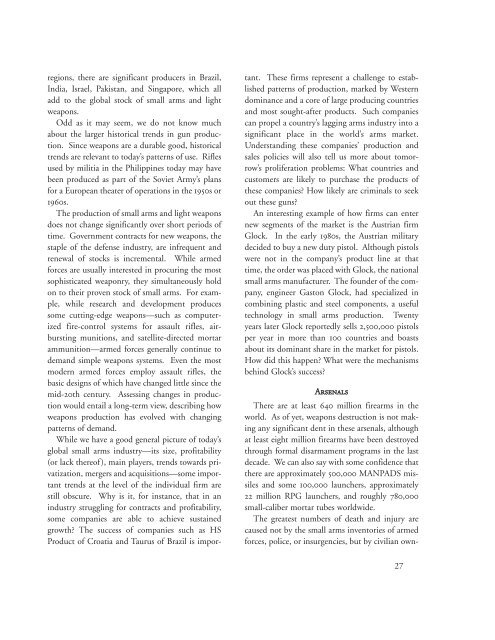Small Arms and Light Weapons - Harry Frank Guggenheim ...
Small Arms and Light Weapons - Harry Frank Guggenheim ...
Small Arms and Light Weapons - Harry Frank Guggenheim ...
- No tags were found...
Create successful ePaper yourself
Turn your PDF publications into a flip-book with our unique Google optimized e-Paper software.
egions, there are significant producers in Brazil,India, Israel, Pakistan, <strong>and</strong> Singapore, which alladd to the global stock of small arms <strong>and</strong> lightweapons.Odd as it may seem, we do not know muchabout the larger historical trends in gun production.Since weapons are a durable good, historicaltrends are relevant to today’s patterns of use. Riflesused by militia in the Philippines today may havebeen produced as part of the Soviet Army’s plansfor a European theater of operations in the 1950s or1960s.The production of small arms <strong>and</strong> light weaponsdoes not change significantly over short periods oftime. Government contracts for new weapons, thestaple of the defense industry, are infrequent <strong>and</strong>renewal of stocks is incremental. While armedforces are usually interested in procuring the mostsophisticated weaponry, they simultaneously holdon to their proven stock of small arms. For example,while research <strong>and</strong> development producessome cutting-edge weapons—such as computerizedfire-control systems for assault rifles, airburstingmunitions, <strong>and</strong> satellite-directed mortarammunition—armed forces generally continue todem<strong>and</strong> simple weapons systems. Even the mostmodern armed forces employ assault rifles, thebasic designs of which have changed little since themid-20th century. Assessing changes in productionwould entail a long-term view, describing howweapons production has evolved with changingpatterns of dem<strong>and</strong>.While we have a good general picture of today’sglobal small arms industry—its size, profitability(or lack thereof), main players, trends towards privatization,mergers <strong>and</strong> acquisitions—some importanttrends at the level of the individual firm arestill obscure. Why is it, for instance, that in anindustry struggling for contracts <strong>and</strong> profitability,some companies are able to achieve sustainedgrowth? The success of companies such as HSProduct of Croatia <strong>and</strong> Taurus of Brazil is important.These firms represent a challenge to establishedpatterns of production, marked by Westerndominance <strong>and</strong> a core of large producing countries<strong>and</strong> most sought-after products. Such companiescan propel a country’s lagging arms industry into asignificant place in the world’s arms market.Underst<strong>and</strong>ing these companies’ production <strong>and</strong>sales policies will also tell us more about tomorrow’sproliferation problems: What countries <strong>and</strong>customers are likely to purchase the products ofthese companies? How likely are criminals to seekout these guns?An interesting example of how firms can enternew segments of the market is the Austrian firmGlock. In the early 1980s, the Austrian militarydecided to buy a new duty pistol. Although pistolswere not in the company’s product line at thattime, the order was placed with Glock, the nationalsmall arms manufacturer. The founder of the company,engineer Gaston Glock, had specialized incombining plastic <strong>and</strong> steel components, a usefultechnology in small arms production. Twentyyears later Glock reportedly sells 2,500,000 pistolsper year in more than 100 countries <strong>and</strong> boastsabout its dominant share in the market for pistols.How did this happen? What were the mechanismsbehind Glock’s success?ArsenalsThere are at least 640 million firearms in theworld. As of yet, weapons destruction is not makingany significant dent in these arsenals, althoughat least eight million firearms have been destroyedthrough formal disarmament programs in the lastdecade. We can also say with some confidence thatthere are approximately 500,000 MANPADS missiles<strong>and</strong> some 100,000 launchers, approximately22 million RPG launchers, <strong>and</strong> roughly 780,000small-caliber mortar tubes worldwide.The greatest numbers of death <strong>and</strong> injury arecaused not by the small arms inventories of armedforces, police, or insurgencies, but by civilian own-27




